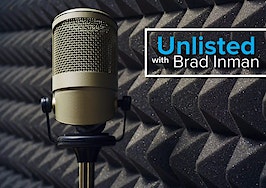- Pricing is both an art and a science, but sellers need to avoid the common mistakes that they often make.
- In a good market, houses go up in value. But the stuff in them doesn’t.
- If the market is telling you something, you’d better listen.
So your clients have decided to sell their home. They’ve had a lot of decisions to make, like hiring an agent — your homesellers need your expertise to actually sell the house, and for things like creating a marketing campaign and deciding how to stage the home.
But the most important decision is simple: pricing.
The nice part about pricing a home is that in most of the country, the real estate market is pretty transparent — consumers can get excellent information about what comparable properties have sold for and what competitive properties are selling for.
It’s not like buying a car, for example, where they have no idea what other people paid for their cars.
So it’s easy, right? Well, not so much. Even in hot markets, many homesellers find themselves languishing on the market for months, often because they made bad pricing decisions.
In most cases, it’s because they made some simple mistakes when pricing their home, or one big mistake afterward.
So here I will describe the common mistakes that sellers make in hopes that you can steer your clients away from making the same blunders when it comes to pricing their home — and I’ll break it down for you the same way I’d explain it to my sellers.
Pricing to the unsolds, rather than the solds
The biggest mistake most sellers make is pricing their home based on what’s for sale, not what’s sold.
Every comparative market analysis is based on an analysis of two types of properties: the ones that have sold and the ones currently on the market. You need to consider both when you’re pricing your home, but for different reasons.
You look at the sold comparables to get a sense of what the home is probably worth, and you look at the unsold listings on the market to get a sense of the pricing you need to beat.
But too many sellers ignore the solds and price their home according to the unsolds — the listings that are currently languishing on the market. Think about the logic of that. You’re trying to sell your home. So why would you price it based on homes that are not sold? If you price it the unsold homes, you’re just going to join them.
No, you price according to what has sold. That’s the market price. The only reason you need to look at the unsold properties is to figure out what you need to do to beat the competition.
In fact, those unsold overpriced homes are great at making your lower-priced home look like a bargain, sort of like when Amazon shows you a higher “list price” on a gadget to make the sales price look like a steal.
If you want to get sold, price to the solds. If you want to be unsold, price to the unsolds. It’s your choice.
By the way, agents don’t help matters by calling unsold homes “actives.” Stop that! It’s just sitting there, doing nothing. What’s so active about that?
Overvaluing the amenities
Another mistake sellers make is that they put too much faith in the value of unique amenities — granite counters, bathroom finishes, high-end appliances and so on.
I was once talking to a seller about how his home was priced over $200,000 more than a comparable property just down the block. His answer: “Well, I have a sauna in the basement.”
OK, but you can put a sauna in your basement for about $10,000, and it’ll be brand new, without anyone else’s dried-up leftover sweat in it. And this guy was pricing it as a $200,000 value.
He’s not alone. A lot of sellers make that mistake. Psychologists even have a name for it — the “endowment effect,” which is our tendency to overvalue things just because we own them.
Amenities do have value, just not enough to make a big difference in price. The old joke in real estate is that value is based on three things: location, location and location. I said it’s an old joke, not necessarily a funny one.
And that’s mostly true. The biggest factor in pricing a home is location, which is obvious to anyone who has priced out a Manhattan apartment. After that, you look at size — how big is the home? And then once you know location and size, you can pretty much establish a general pricing range. That’s when you start looking at all the other aspects of the home: style, condition, lot quality — and the amenities.
So amenities are important because they can change where you are in that range. But they don’t move you up to a new one.
Trying to get full value for improvements
Not only do many sellers overvalue their amenities, they particularly overvalue any improvements they made in the home.
Let’s say that 10 years ago they bought the home for $500,000. Five years ago, they spent $50,000 redesigning the kitchen. Then two years ago, they spent $25,000 on roof repairs. So at the very least, even if the home hasn’t appreciated in value at all, they should be able to sell the home for $575,000, right? Haven’t they improved the house by $75,000 with all the work they did?
Not really. No one ever gets 100 cents on the dollar for the improvements put in.
If you don’t believe me, check out the results of Remodeling Magazine’s yearly “Cost versus Value” report; it tracks the impact of standard remodeling projects on resale value. In most cases, improvements earn back about 60 percent to 70 percent of what they cost.
Why? Think of it this way: Almost every thing you’ve ever bought has gone down in value since you bought it — cars, computers, pianos, anything. Once it’s used, it starts to depreciate, right?
Well, that doesn’t change just because you took that thing and stuck it inside a house. Even if your house goes up in value, it doesn’t mean that everything in the house goes up in value, too. That refrigerator you put in went down in value. Those cabinets went down in value. The new roof went down in value. They’re all used now, just like your car is used.
In a good market, houses go up in value. But the stuff in them doesn’t.
Pricing based on what the sellers ‘need’
Sometimes, sellers make the mistake of pricing according to the next home they want to buy, not the home they own now.
That is, they don’t even look at the comps. All they care about is what they need for the down payment on their next home, and they figure out the price from there: “Let’s see. I still owe $200,000 to the bank, and I need $100,000 as a down payment for my new home, so we’ll price it at $300,000.”
Here’s the problem: no one cares what they need.
It’s nothing personal. After all, they do the same thing. A seller might be buying a home after selling the current one, right? And will the now-buyer care what those sellers need for their next purchase? Not so much.
Markets don’t work like that. Buyers don’t price homes in a vacuum: they make offers based on what other homes have sold and are selling for. Real estate provides an open and transparent market, so sellers can’t price their homes according to their personal needs.
It works both ways. If sellers get an offer that’s too low, they don’t care if the buyer says, “But that’s all I can pay!” They don’t give discounts based on need, so they shouldn’t expect a premium, either.
Falling in love with the AVM
Finally, sellers make the mistake of relying too much on a Zestimate.
At least, they price their home according to the Zestimate if it comes in really high. If it comes in low, then it’s obviously just a stupid computer glitch and can be safely ignored.
And it’s not just the Zestimate. Automated valuation models, or AVMs, are available everywhere now, including on a lot of broker websites. They’re fun in a real estate porn kind of way.
But sellers need to understand that AVMs were designed to provide quick and easy macro-level valuations for institutional investors who didn’t have the time or ability to do a detailed analysis. No one thinks that they’re as accurate as an actual comparative market analysis from a professional real estate agent or appraiser — not even the people who created them.
After all, Zillow itself admits to a national median error rate of about 8 percent, which means that half the Zestimates are off by more than 8 percent. So for homes with Zestimates of, say, $400,000, only half those homes are going to sell inside a range of about $368,000 to $432,000. The other half is worth more or less than that range.
Sellers should think about how they would feel if an agent came to their house and said, “Well, my advice would be to price it somewhere between $368,000 and $432,000, and I’m confident that we have a 50 percent chance of selling it within that range. Yay for me!”
Would a seller have a lot of confidence in that agent? Well, then, they shouldn’t fall in love with that AVM.
And the one mistake sellers make afterward
Finally, even if sellers avoid the five big mistakes when they’re pricing their home, they can still make a mistake afterward — namely, they set it and forget it.
Even in the best of circumstances, the initial home price is a guess. Pricing is both an art and a science, and you never quite know exactly how the market is going to react when you list a home.
Indeed, from a pure Economics 101 perspective, it almost doesn’t matter where sellers initially price a home because the market is going to correct them.
If they price it too high, the home will languish on the market as buyers take a pass until they reduce it. And if they price it too low, they’ll drive intense buyer demand that can drive the price up over asking. Either way, through reductions or bidding wars, they end up at the true market price.
But those economic fundamentals depend on listening to what the market is saying.
- What feedback are you getting from agents?
- What are buyers saying?
- What kind of traffic is your listing getting online?
- Is that traffic turning into showings?
- Into offers?
- Have other homes on the market sold?
- What for?
- And what happened to the buyers who did come to look at your home?
- Did they buy something else?
In other words, sellers need to stay engaged and involved in the marketing of their home and listen to what the market is saying. If the market is telling you something, they’d better listen.
With all that said, sellers need to remember one thing: they’re the boss.
You work for your seller. You should give your clients all the information they need to make an informed decision on price. Ideally, they should consider all that information and make a reasonable decision.
At the end of the day, though, it’s their home. If they want to price it to the unsolds or price it to what they need or get every dollar they put into it — then that’s their call.
But it’s kind of on them if they go against your recommendations and are still living in a home for sale six months later.
Joseph Rand is one of the managing partners of Better Homes and Gardens Real Estate – Rand Realty in New York and New Jersey and blogs about his local markets at the Rand Country Blog and about the industry at ClientOrientedRealEstate.com.









